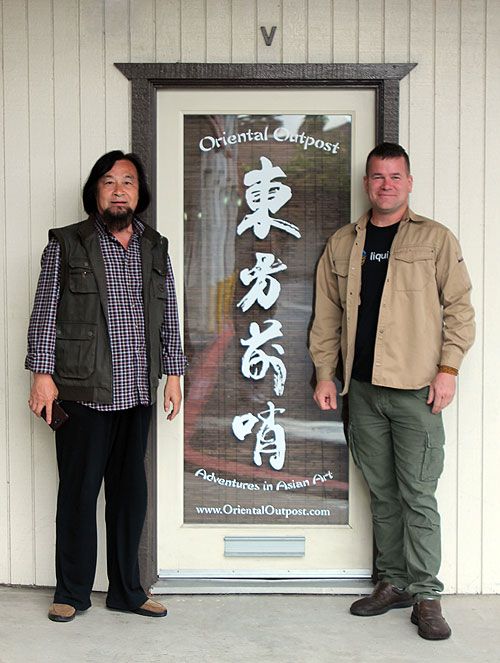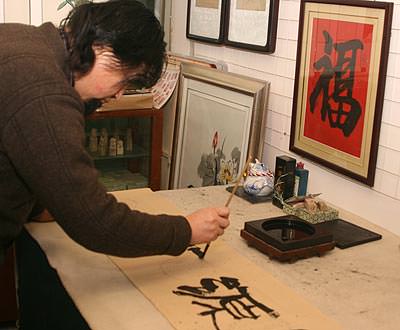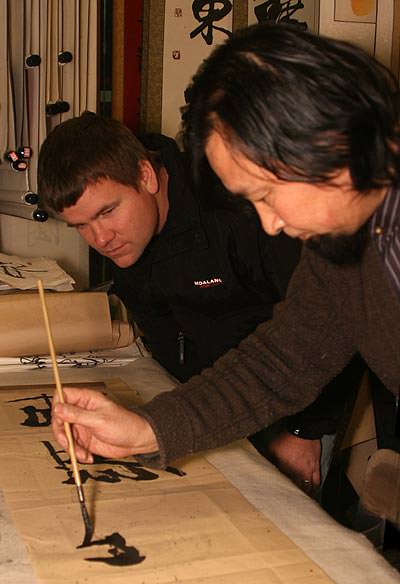
74½"
19½"

Approximate Measurements
Artwork Panel: 31.3cm x 133.7cm ≈ 12¼" x 52½"
Silk/Brocade: 40.4cm x 189cm ≈ 16" x 74½"
Width at Wooden Knobs: 49.4cm ≈ 19½"

Close up view of the artwork mounted to this silk brocade wall scroll




While this is a newly created wall scroll, the poem on this scroll was written almost 1200 years ago during the Tang dynasty. It depicts traveling up a place known as Cold Mountain, where some hearty people have built their homes. The traveler is overwhelmed by the beauty of the turning leaves of the maple forest that surrounds him just as night overtakes the day, and darkness prevails. His heart implores him to stop and take in all of the beauty around him.
First before you get to the full translation, I must tell you that Chinese poetry is a lot different than what we have in the West. Chinese words simply don't rhyme in the same way that English or other Western languages do. Chinese poetry depends on rhythm and a certain beat of repeated numbers of characters.
I have done my best to translate this poem keeping a certain feel of the original poet. But some of the original beauty of the poem in its original Chinese will be lost in translation.
Far away on Cold Mountain, a stone path leads upwards.
Among white clouds people's homes reside.
Stopping my carriage I must, as to admire the maple forest at nightfall.
In awe of autumn leaves showing more red than even flowers of early spring.
Hopefully, this poem will remind you to stop, and "take it all in" as you travel through life.
The poet's name is "Du Mu" in Chinese characters that are written,

 .
.
He lived from 803-852 AD and was a leading Chinese poet during the later part of the Tang dynasty.
He was born in Chang'an, a city of central China and the former capital of the ancient Chinese empire in 221-206 BC. In present-day China, his birthplace is currently known as Xi'an, the home of the Terracotta Soldiers.
He was awarded his Jinshi degree (an exam administered by the emperor's court which leads to becoming an official of the court) at the age of 25, and went on to hold many official positions over the years. However, he never achieved a high rank, apparently because of some disputes between various factions, and his family's criticism of the government. His last post in the court was his appointment to the office of Secretariat Drafter.
During his life, he wrote scores of narrative poems, as well as a commentary on the Art of War and many letters of advice to high officials.
His poems were often very realistic, and often depicted everyday life. He wrote poems about everything, from drinking beer in a tavern to weepy poems about lost love.
The thing that strikes you most is the fact even after 1200 years, not much has changed about the beauty of nature, toils, and troubles of love and beer drinking.
This piece is painted with special Chinese ink on xuan paper (rice paper) mounted to a traditional silk-brocade wall scroll.

Xing An-Ping and I in front of my studio door in California, 2016.
He wrote the calligraphy for the logo on my door.
This was during a trip when Xing An-Ping, his wife, son, daughter-in-law, and grandchild came to visit and vacation with us in the USA.
As we came out of the Chinese New Years holiday in February 2017, I got a message from Master Calligrapher Xing An-Ping that he had been admitted to the hospital with a probable case of pneumonia.
A couple weeks later, he informed me that the diagnosis was leukemia. All of us were quite shocked. However, Xing An-Ping indicated that he fully planned to write calligraphy between his weeks of chemotherapy.
I knew the future might be bleak, but I expected that difficult future was a few years away.
On April 8th, 2017, I received a message from his wife. Xing An-Ping passed from this life and started his journey to the next. His death is a huge shock.
I am proud and honored to have been able to call myself his friend for the past 12 years. We were so close that my family and his vacationed together just last year in California.
I learned so much from him, and he provided my customers such great calligraphy all these years. He would occasionally mention how very satisfied he was to know that his artwork now hangs in the homes of people in roughly 65 countries around the world. And now that calligraphy is his legacy that lives on.
This loss is so great that I am having trouble even articulating just what this means to myself, my wife, and my small staff at Oriental Outpost. The artists that I work with in this business have always felt like family to me, perhaps now more than ever.
Master Calligrapher Xing An-Ping is a famous calligrapher in Beijing. He's been published and interviewed in magazines numerous times. In Beijing, a city known for its high level of scholarship and calligraphy, Xing An-Ping is rated in the top 200 living masters of calligraphy.
Master Xing is not only an expert in nine different Chinese scripts, but also can write any of more than 40,000 characters in the Chinese and Japanese lexicons, including alternate forms, without reference to any books. This is very rare, as most calligraphers must consult special reference books to find rare and alternate forms of many characters. Most literate Chinese people of this generation can only read 5000 characters, and perhaps write 3000 of them without reference.
His belief is that art is more important than politics. Therefore, he is more than willing to write Japanese words and phrases. This is rare for a Chinese calligrapher, as most still hold strong distaste for Japan due to the atrocities in Nanking (Nanjing) before and during WWII.
He believes that all religions should be respected. While he sees himself as a Buddhist, and meditates before writing all of this calligraphy, he carefully creates Christian, Jewish, Muslim, and other religious calligraphy artwork upon request of customers in China and around the world.
Unlike many or most Chinese men, Master Xing does not smoke or drink. He eats mostly vegetables and not too much meat (Yes, contrary to popular belief, many Buddhists do eat meat - in moderation). His healthy lifestyle is probably why he is in his late-50's, but looks like he is 40.
He speaks in sophisticated Chinese - they way you expect a doctor or professor to speak. My Chinese is at about the level of a 3rd-grader, so he has to "dumb down" his Chinese when he and I have a conversation.

Master Calligrapher Xing An-Ping filmed for the 2008 Olympics by NBC.

Master Calligrapher Xing An-Ping and I
visit at his studio in the
Haidian District of Beijing.
When I met Master Xing, in early 2005, I had already looked through the studios of almost 100 top-rated calligraphers, in search of the one I wanted to work with (a process that took two years). I liked the quality and styles I saw in his studio, and we sat down to talk. I told him of my plan to bring very personal and customized Chinese calligraphy to the masses. We talked about catalogs of high-level calligraphy that sells for $2000-$5000 for a single wall scroll. This is fine for a collector of Asian calligraphy, but it puts it out of reach of the common people. I told him that my plan was to offer a beautiful product at an affordable price, while at the same time, educating people about calligraphy and Chinese culture.
He agreed to lower his price in favor of these ideas:
1. His artwork being displayed in over 60 countries around the world.
2. His part in providing education and knowledge about this special art.
3. The fact that I was going to potentially keep him busy with lots of interesting projects.
The final philosophy is, "The legacy of this artwork far outweighs the money received for creating it".
I also found a kindred spirit with Master Xing in the fact that he cares as much about quality as I do. I've always been picky about quality, and thus spent years searching for the best scroll maker in all of China. When I found him, I helped him set up the best mounting workshop ever. We even imported special saws from Sweden, had huge custom glass-top tables made, and recently bought the largest and best artwork press that they make.
Before Master Xing would work with me, he sent me away with a piece of his raw calligraphy to have mounted as a scroll at our workshop. Master Xing had his own favorite mounter, and knowing the quality issues (or lack there of), he wanted to make sure his artwork was going to be mounted using the best materials and craftsmanship. When I brought the scroll back a few days later, he said, "Wow, this is better than mine". He now gets his own artwork for domestic sale at his studio, mounted at our workshop.

The master calligrapher creates his craft using
traditional and classic materials.

In the past few years, I have become very serious
in my appreciation of Asian calligraphy.
Just watching the way a good calligrapher gracefully
moves and pauses his brush can be mesmerizing.